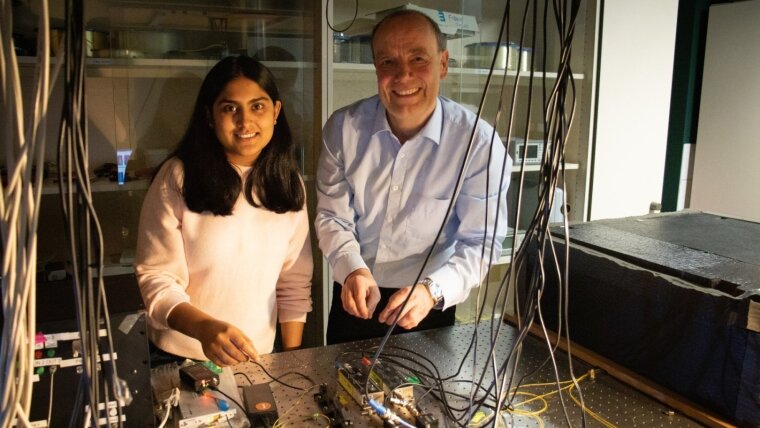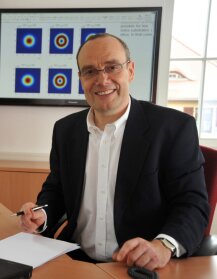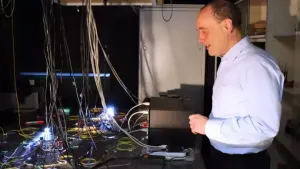
- Light
Published:
Prof. Dr. Ulf Peschel and his team report in the magazine "Science" that the propagation of optical pulses through a glass fiber follows the rules of thermodynamics.
Image: Ira Winkler/Universität JenaIn our modern society huge amounts of data are transmitted every day, mainly as short optical pulses propagating through glass fibers. But with increasing density also interactions of these pulses growth causing potentially a loss of information. Physicists at the Friedrich Schiller University Jena and of the College of Optics and Photonics in Orlando, Florida have investigated how to control large numbers of optical pulses and how to reduce the effect of those interactions. To this end they have monitored the evolution of such an ensemble of optical signals and have found that it still follows some rules, but mainly those of thermodynamics. In todays (10.3.23) issue of the renowned journal “Science”External link the team around Prof. Dr. Ulf Peschel reports about measurements on a sequence of pulses propagating thousands of kilometers through a few microns thin glass fiber.
Surprising results
The researchers were surprised by the results. “We have found that already after hundred kilometers pulses start organizing themselves and from now on, they behave more like molecules of a conventional gas as e.g. air”, reports Prof Ulf Peschel, the head of the group in Jena. In a gas all particles propagate into different directions, but still they have a mean velocity defined by the temperature. Although light pulses propagate with a huge speed of about 200.000 kilometers per second along the fiber, they are not equally fast. “The statistical distribution of their velocities equals exactly that of a conventional gas with a fixed temperature”, says Peschel.
As the researchers have now demonstrated for the first time in their recent publication this photon gas can be cooled by adiabatic expansion. Similar as in a real gas velocity differences decrease during cooling, and the sequence of pulses becomes more ordered. If the absolute temperature zero at 0 Kelvin is reached, all pulses propagate with the same velocity.
Infinite temperature
Also, the opposite process can occur. “During heating velocity differences increase”, explains Peschel. If all possible pulse velocities are equally populated disorder is maximum corresponding to infinite temperature – a state which cannot be reached in a real gas as it would require an infinite amount of energy. “In contrast a periodic refractive index modulation can limit the range of allowed pulse velocities in the glass fiber. In that case all available velocity states can be equally excited creating such photon gas with infinite temperature. If further energy is transferred to the gas states of extreme velocities are preferentially populated – the photon gas becomes hotter than infinitely hot.
“Such up to now only theoretically predicted photon state is mathematically described by a temperature below absolute zero”, says Peschel. He and his colleagues have prepared such a negative temperature photon gas and for the first time shown that it obeys the laws of thermodynamics. “Our results will contribute to a better understanding of the collective behavior of large ensembles of optical signals. If we take the laws of thermodynamics into account, we can make data transmission more robust and reliable, for example by using pulse sequences which fit better to thermal distributions.”
Original publication:
A. L. Marques Muniz, F. O. Wu, P. S. Jung, M. Khajavikhan, D. N. Christodoulides, U. Peschel, „Observation of photon-photon thermodynamic processes under negative optical temperature conditions,“ Science VOLUME 379|ISSUE 6636|10 MAR 2023, https://www.science.org/doi/10.1126/science.ade6523Externer LinkExternal link

